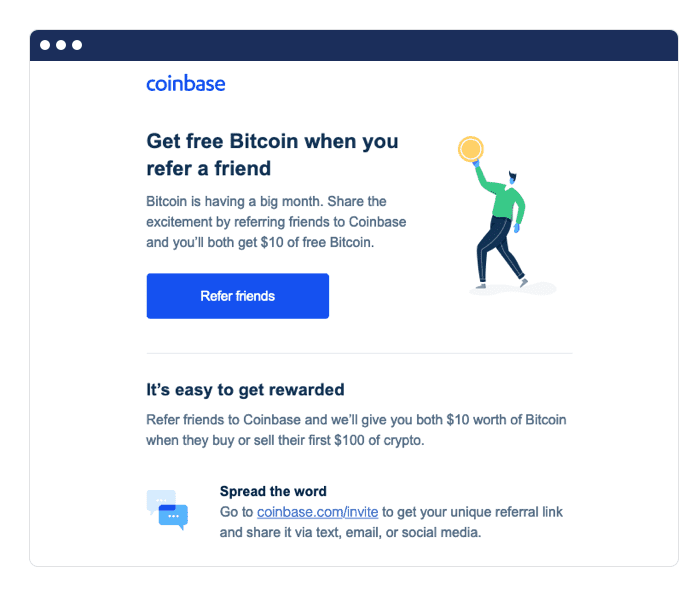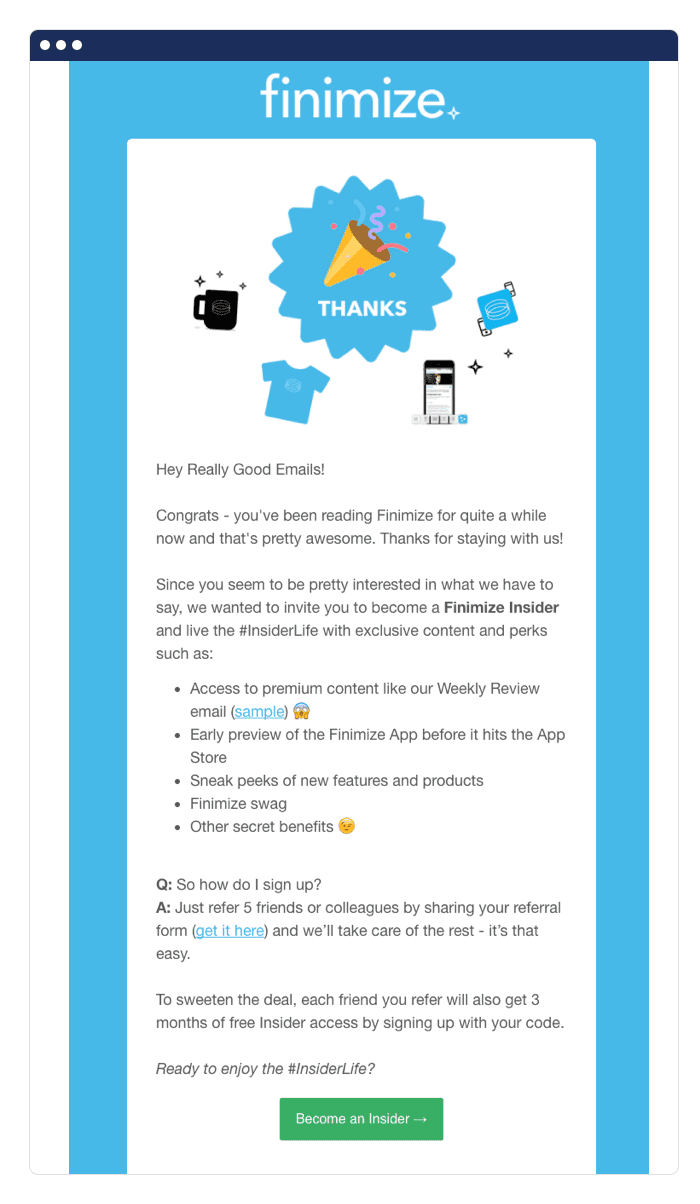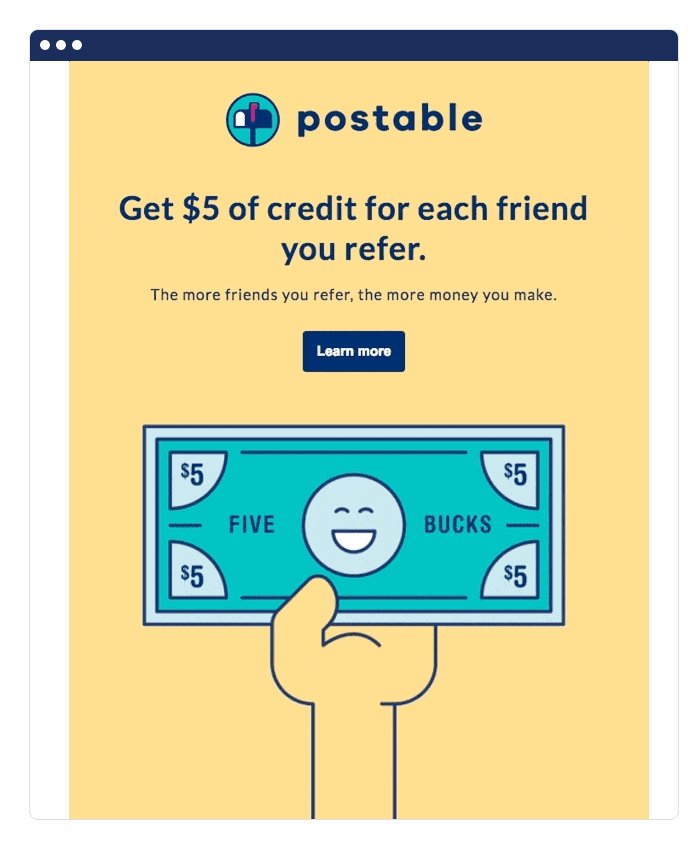- All Posts
- /
- How to create great referral emails

How to create great referral emails
Messaging and Automation-
 Stephanie Knapp
Stephanie Knapp
-
Updated:Posted:
On this page
If you have ever asked a friend where they get their haircut, or bought new food after trying it at a friend’s house—a referral has influenced you. Whether you directly ask for recommendations from those around you, or just take a cue from what they’re doing, referrals are a powerful marketing strategy.
So what exactly is a referral email? It’s a message where you ask an existing customer to share your brand with someone in their network. Typically, there’s an incentive for your customer if the person they referred buys from you.
Referral emails are great additions to your email marketing strategy, but it can feel daunting to get right. How do you ask? When do you ask and what do you offer?
If you’re trying to set up your first referral email or improve your current one, you’ve come to the right place. We’re going to cover examples and some best practices to get you started with confidence.
Why Referral Emails Work – The Three T’s
Before we jump into details like referral email templates or design, let’s unpack why they work so well. Referral leads convert 30% better and have, on average, a 16% higher lifetime value. Plus, 54% of marketers see lower costs-per-lead with referral marketing than other channels.
So what gives referral emails their magic? There are three components.

Targeting
You can’t “copy and paste” your most engaged users, but referrals come close. By sending referral emails to people who are already ideal customers, you boost the chances of reaching your target audience without the need for “look-a-like audiences” on Facebook Ads or “similar audiences” on Google Ads and advanced paid ad targeting strategies. This is because your current customers can share their opinions with their friends of colleagues in similar positions or industries.
Trust
Are you more likely to believe a stranger or a friend? It’s no surprise that 92% of consumers trust recommendations from someone they know. Plus, a recommendation from a friend feels a lot less like an ad than, well, an ad from a company.
Timing
Context is essential to consider in all marketing, and referrals are no exception. Luckily, your existing customers may be able to tailor who they refer you to based on information you don’t have.
Imagine you’re a company that sells surfboards. You send an email to a recurring customer about your new referral program, and they remember that their friend is in the market for a new board.
After all, a close friend is going to have more access to details about what’s going on in a potential customer’s life than what Facebook may be able to provide (at least, not at the low cost of a referral).
Referral Email Inspiration and Examples
It’s always helpful to put a face to a name, and in this case, we’ll look at referral email examples. Here’s a collection of messages that you can use to create your referral email template.
Azendoo gauges customer sentiment
Who should you send a referral email to? Azendoo takes the approach of gauging net promoter scores first. By asking how likely a customer is to recommend the company to a friend or colleague, they can find the users who would be most likely to pass along a referral offer.

Dosh keeps referral CTAs at the bottom of emails
While it’s a good idea to filter who receives referral messages at least to some degree, you can take more than one shot. In the example from Dosh below, there’s a referral program CTA at the bottom of the email.

Including a section about your referral program at the bottom of promotional emails for engaged customers, helps keep it top of mind for readers.
Coinbase explains its program step-by-step
Below is an excellent example of an email introducing your referral program. Coinbase has a quick explainer and CTA in the header section of the email, but they go into further detail in the body.

Concepts are more memorable when presented in groups of three, and Coinbase has taken advantage of this. Listing out what a person has to do, as well as what reward everyone will receive, gives customers the info they need to get started.
Equal Parts uses content and community
Want to start including referral CTAs in your emails but aren’t sure what messages to pair it with? Take a cue from Equal Parts and lean into the idea of community through content.

Equal Parts sells cookware, so its content focuses on food. The email starts to embrace the community by bringing in quotes from employees, and then continues with the referral ask. “Cooking is better together” is Equal Parts’ way of positioning their referral program as something nice you can do with your friends.
Saje also leans into the power of friendship
Similar to Equal Parts’ referral positioning, Saje kicks off their email with the headline “spread wellness to your friends.”

Rather than focusing on the monetary benefits of referring a friend, Saje leans into the power of friendship. They remind current customers of their value proposition, which is wellness, and make readers feel as though promoting this company is actually something nice to do for your friends and family.
Outdoorsy offers varying referral levels
Depending on the setup of your product or service, you may be able to offer different levels of referral. For example, Outdoorsy has two referral levels depending on whether the friend rents or lists an RV. In this case, there may be varying levels of referrals based on different types of customer actions.

In addition to different referrals for varying actions, you could also offer a sliding referral scale. For example, the larger the purchase made by the referred person, the bigger reward for the original customer.
Remote invites new users to join
While most of your referral email planning will be for your current customers, don’t forget about what new users see! Remote has a simple email to let a person know their friend has referred them.

The email is clear about who invited them and what they were invited to do. Keeping in mind that the referred person may have never heard of the company, Remote also includes social proof.
Webflow offers quicker access
Your referral offers aren’t limited to cashback. Webflow lets users know that they could gain access to the beta product faster if they shared it with friends.

Have a much-anticipated feature release coming up? Try offering early access to your most engaged customers in exchange for sharing your company with friends and colleagues.
Finimize lets users know why they were chosen
Who wouldn’t like to be invited to a special club? Finimize uses exclusivity as the basis of the positioning for their referral and membership program. The email starts by giving users context about why they were chosen. If a customer is highly engaged, acknowledge and thank them!

The Finimize email also outlines the benefits of becoming a “Finimize Insider,” and presents the “catch” of needing to invite five friends.
Setapp offers free time
Need more ideas on what to offer customers? Setapp gives their users a free month, up to half a year, for each new person they refer.

Ideally, this offer for a free month of service will entice users to send you high-quality leads who are likely to convert.
How to write a referral email
Step 1: Find your biggest advocates
Your first order of business in creating a referral email strategy is to decide who to send the message to. Since you want to increase your chances of success and avoid annoying users, you need to identify your biggest advocates.
To do this, get into the habit of sending NPS surveys.Insurify sends a simple NPS email, and you can also deploy them on your site or app. From these results, your promoters will naturally show themselves.

If you don’t have NPS data to work with, look for your most engaged users, frequent shoppers, or customers with high lifetime value. Make sure that you’ve had time to share value and build a relationship before asking for a referral. That influx of big spenders after your Black Friday sale isn’t your strongest option.
Step 2: Choose your engagement strategy
Once you’ve found a segment of users to start sending referral emails to, you need to decide how and when to contact them. Your “how” will likely be via email, though you may choose to send reminders via push notifications.
After you’ve decided how to tell users about your referral program, you need to choose a sharing mechanism. That is, how will your customers share you with their friends? You could create a special referral code or link. Alternatively, you can populate a message for them to automatically share on socials such as Facebook Messenger, text message, email, WeChat, and more.
Another element to consider is how you’ll engage newly referred users. You need an email to send them as soon as someone refers them, as well as a new lead nurturing sequence that introduces your brand.
You also need to create an email or notification for your customer that lets them know when they’ve successfully referred someone, and how they can redeem their reward.
This step is also the point in your strategy to determine your KPIs and set goals. If you already have a referral campaign, your focus is seeing better results than in the past. If you don’t have a company baseline yet, you can base your conclusions on the global average referral rate of 2.3%.
To calculate your referral rate, you’ll count how many sales in a given time came from referrals. For example, if you had 4 referred purchases out of 200 in May, your referral rate would be 2%.
Step 3: Choose an incentive
Some customers may refer you out of the goodness of their heart, while others may need an incentive. Examples of offers include:
- Cashback when the referred customer makes a purchase
- Access to new features or exclusive products
- Membership in an “ambassador” program where they can vote on future developments
- Free products in exchange for referrals
- Discounts on services or free months of subscriptions
When deciding on your offer, think about what would be useful for customers and attainable for you. You wouldn’t want a repeat of that Hoover free flight promotion. If your price points or average orders are low, you’ll want a small cashback offer like Postable.

Step 4: Decide on positioning
Figuring out how to mention a referral in an email can feel like a sensitive topic. After all, you’re not trying to be pushy or feel like you’re asking for a handout. The best positioning for your audience will vary based on your industry and customers, but a good rule of thumb is to focus on how it helps the referrer. You can play up the reward or make your current customer feel good about helping out their friends.
Step 5: Send and optimize
Now it’s time to send your email. If this is your first referral campaign, it may be wise to send the campaign in batches. Sending the campaign to a smaller sample and seeing how they react prevents you from sending an accidental bad campaign to a large list.
After you’ve sent the referral email campaign and are seeing some results, you get to move on to optimizing.
A/B test your offers and positioning, and play around with using engagement data to target ideal users.
Once you learn about which types of customers lead to the most productive referrals, you can set up triggers to automate your referral campaigns.
To take it a step further, you could create seasonal referral campaigns like Betterment did. The company’s referral campaign took a comedic (and relatable) detour into discussions at family holidays, while slipping in benefits of the service.

You may also want to adopt specific referral software to automate your process once it’s proven. Tools such as ReferralCandy, Talkable, and Smile.io all help you make the most of your referral program.
Referral emails are great to add to your messaging mix because they use the power of the relationships you’ve already earned to generate new business. If you prioritize sending the campaigns to your most-engaged customers first and creating an offer they care about, you’ll be off to a great start.
Want to be a better email marketer? Check out our tips for sending out dramatically better emails.

